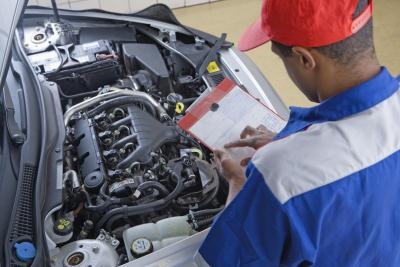
The intake manifold on the four-cylinder Chevrolet S10 is a two-piece intake, with a gasket located between the lower and upper intake manifolds. If the bottom intake manifold gasket is leaking, you should replace both, since the upper intake must come off to gain access to the lower intake manifold gasket. If only the upper intake manifold is leaking, there is no need to replace the lower intake manifold gasket.
Locate the relay box near the driver's side fenderwell. Lift the cover, and using the diagram on the underside of the cover, locate and remove the fuel pump relay. You should be able to pull it out of its socket with your fingers. If not, use a pair of needle nose pliers.
Disconnect the negative battery cable and set it aside, ensuring that it does not touch metal. Mark all the vacuum lines and wiring harness connectors on the upper intake manifold and throttle body. Loosen the hose clamps on all the vacuum lines on the throttle body, using the screwdriver. Pull the hoses off the throttle body.
Remove the throttle cable support bracket and the throttle body assembly, using the appropriate socket. Disconnect the vacuum brake booster hose, using the screwdriver. Remove the EGR pipe retaining bolts, using the appropriate socket. Remove the EGR adapter bolt, then remove the EGR pipe.
Unplug the idle air control motor, manifold absolute pressure sensor, throttle position sensor and the fuel injector harness connectors. Remove the right fender wheelhouse extension, using the appropriate socket.
Remove the retainers for the engine harness bracket, the transmission filler tube and the fuel system evaporator pipe, using the appropriate sockets. Disconnect the fuel pipes from the fuel rail, using the appropriate line wrench.
Disconnect the accelerator cable, and if you have cruise control, the cruise control cable, from the intake manifold, using the screwdriver. Mark the spark plug wires, using the tape and marker. Remove the spark plug wires from the plugs only. Remove the spark plug wire harness retainer from the heater hose pipe and set it aside.
Remove the engine wiring harness bracket located at the rear of the head, using the appropriate socket. Remove the intake manifold bolts, using the appropriate socket. Remove the fuel rail, using the appropriate socket. Lift the upper intake manifold off the lower intake manifold. Clean the gasket mating surface of the top of the lower intake manifold and the upper intake manifold, using shop rags, and if needed, a plastic scraper.
Fit the manifold gasket onto the top of the lower intake manifold gasket. Lower the upper intake manifold into place and tighten the bolts firmly. Reinstall the engine wiring harness bracket and tighten the bracket-to-valve bolts to 88 inch-pounds of torque. Tighten the bracket-to-cylinder bolt to 18 foot-pounds of torque.
Reinstall the spark plug wire harness and retainer. Reattach the spark plug wires to the plugs, ensuring that they snap into place. Reinstall the throttle body assembly, throttle cable support bracket and vacuum lines. Reattach the accelerator and cruise control cables. Reconnect the fuel lines. Install the engine harness bracket retainers, transmission filler tube and fuel system evaporator pipe, and tighten the bolts.
Plug in the idle air control motor, manifold absolute pressure sensor, throttle position sensor and the fuel injector harness connector. Reinstall the wheelhouse extension. Reinstall the EGR adapter and tighten the bolts to 97 inch-pounds of torque. Reinstall the EGR pipe to the EGR adapter. Tighten the bolts and tighten them to 18 foot-pounds of torque. Reinstall the EGR pipe-to-intake manifold bolts and tighten them to 89 inch-pounds of torque. Reinstall the brake booster hose.